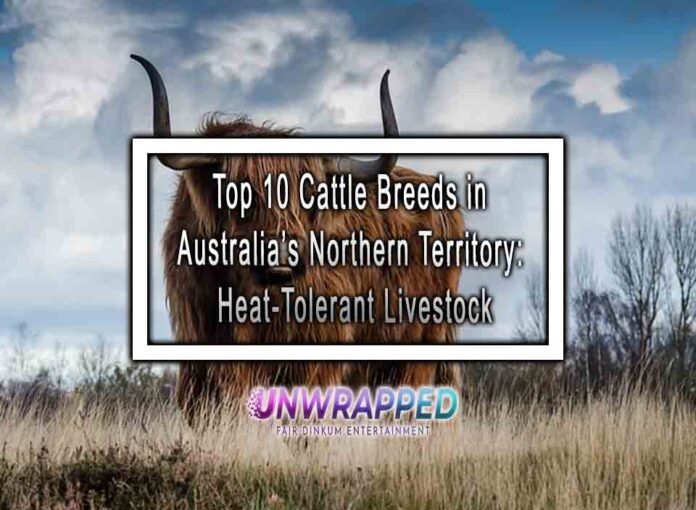Australia’s Northern Territory is a region of vast outback landscapes, extreme heat, and rugged conditions. Livestock farming, particularly cattle ranching, is a key industry in this region, where breeds must thrive in challenging environments. Heat tolerance, disease resistance, and grazing efficiency are essential traits for cattle raised in the Northern Territory.
This article highlights the top cattle breeds suited to the Northern Territory, focusing on their characteristics, adaptability, and contributions to the region’s cattle industry.
Top 10 Cattle Breeds in the Northern Territory
1. Brahman
- Key Characteristics: Light gray or red coat, large hump, and loose skin.
- Primary Use: Beef production and crossbreeding.
- Fun Fact: Brahman cattle are the most popular breed in the Northern Territory, prized for their exceptional heat tolerance and ability to thrive on low-quality forage.
2. Droughtmaster
- Key Characteristics: Red coat, medium-to-large size, and resilience to heat and ticks.
- Primary Use: Beef production.
- Fun Fact: A breed developed in Australia, Droughtmaster cattle are a cross between Brahman and British breeds, combining toughness with quality beef production.
3. Santa Gertrudis
- Key Characteristics: Reddish-brown coat, large frame, and adaptability.
- Primary Use: Beef production.
- Fun Fact: Santa Gertrudis cattle are known for their resilience in harsh climates and produce high-quality beef, making them a favorite for the export market.
4. Brangus
- Key Characteristics: Black or red coat, a cross between Brahman and Angus.
- Primary Use: Beef production.
- Fun Fact: Brangus cattle are popular in the Northern Territory for their heat tolerance, disease resistance, and tender, marbled beef.
5. Charbray
- Key Characteristics: Light cream or white coat, a mix of Brahman and Charolais.
- Primary Use: Beef production.
- Fun Fact: Charbray cattle are renowned for their rapid growth and adaptability, making them a great choice for extensive grazing systems in the Northern Territory.
6. Australian Braford
- Key Characteristics: Red-and-white coat, medium frame, and tick resistance.
- Primary Use: Beef production.
- Fun Fact: Developed in Queensland, Braford cattle are highly suited to the Northern Territory’s tropical and semi-arid regions due to their resilience and productive grazing.
7. Senepol
- Key Characteristics: Solid red coat, medium frame, and naturally polled (hornless).
- Primary Use: Beef production.
- Fun Fact: Senepol cattle, originally from the Caribbean, are increasingly popular in the Northern Territory for their heat tolerance and tender beef.
8. Belmont Red
- Key Characteristics: Red coat, medium size, and excellent fertility.
- Primary Use: Beef production.
- Fun Fact: Belmont Red cattle, developed in Australia, are known for their ability to thrive in hot climates while producing quality beef.
9. Bos Indicus Crossbreeds
- Key Characteristics: Varying coat colors, medium-to-large frame, and hybrid vigor.
- Primary Use: Beef production.
- Fun Fact: Crossbreeding Bos Indicus breeds like Brahman with European breeds enhances adaptability while improving meat quality, making these hybrids a staple in the Northern Territory.
10. Nguni
- Key Characteristics: Multicolored coat with unique patterns, small-to-medium size, and hardy disposition.
- Primary Use: Beef production.
- Fun Fact: Originally from Africa, Nguni cattle are gaining attention in the Northern Territory for their exceptional drought resistance and low-maintenance grazing needs.
Sustainability and Adaptation in the Northern Territory
- Rotational Grazing: Ranchers use rotational grazing to manage native pastures and reduce overgrazing, ensuring long-term sustainability.
- Water Management: Efficient water systems, including bores and dams, are essential for supporting large herds in remote areas.
- Crossbreeding Programs: Crossbreeding heat-tolerant Bos Indicus breeds with European breeds improves beef quality while maintaining resilience.
- Export Focus: Northern Territory ranchers focus on producing high-quality beef for export markets, particularly in Asia.
Interesting Facts About Cattle Farming in the Northern Territory
- Cattle Stations: The Northern Territory is home to some of the world’s largest cattle stations, including Anna Creek Station, covering thousands of square kilometers.
- Live Export Hub: Darwin is a major hub for live cattle exports, primarily to Southeast Asia.
- Extensive Grazing: Due to the vastness of the region, most cattle are raised on extensive grazing systems, relying on natural pastures.
- Heat Adaptation: Breeds like Brahman and Droughtmaster are specifically chosen for their ability to withstand temperatures exceeding 40°C.
Frequently Asked Questions
Q: Which cattle breed is best for heat tolerance in the Northern Territory?
A: Brahman cattle are the top choice for heat tolerance, followed by Droughtmaster and Santa Gertrudis.
Q: What is the most popular beef breed in the Northern Territory?
A: Brahman is the most widely raised breed, with Droughtmaster and Brangus also being popular for their quality beef and resilience.
Q: How do ranchers manage cattle in the Northern Territory’s remote areas?
A: Ranchers use advanced technologies like GPS tracking, drones, and automated water systems to monitor and manage large herds over vast distances.
Q: Are there any locally developed breeds in Australia’s Northern Territory?
A: While not exclusive to the Northern Territory, Australian breeds like Droughtmaster, Belmont Red, and Braford were developed to thrive in similar conditions.
Conclusion: Resilient Breeds for a Challenging Environment
Cattle farming in Australia’s Northern Territory is a testament to human ingenuity and adaptability. From the heat-tolerant Brahman to the versatile Droughtmaster and Santa Gertrudis, these breeds thrive in one of the world’s most challenging agricultural environments.
As global demand for premium beef grows, the Northern Territory’s cattle industry will continue to lead the way, showcasing sustainable and innovative livestock practices that maximize productivity in even the harshest conditions.
See Also: The Ultimate Guide to Cattle Breeds in Israel: From Holsteins to Local Varieties










